2 青岛海洋科学与技术试点国家实验室, 海洋地质过程与环境功能实验室, 山东 青岛 266237;
3 南京大学, 中国南海研究协同创新中心, 江苏 南京 210093;
4 日本高知大学, 海洋岩芯高级研 究中心, 日本 高知783-8502;
5 青岛海洋科学与技术试点国家实验室, 海洋同位素与地质年代测定平台, 山东 青岛 266237)
海洋是地表系统中最大的碳库, 在全球碳循环中起着重要的作用, 显著影响着地球气候系统[1~3]。从地质历史时期上看, 沉积物中有机碳埋藏对气候系统变化的敏感响应具有冰期旋回长时间尺度的周期性变化[4~5];而前人的研究更多聚焦于冰期旋回中大气和海洋碳库之间CO2的转移, 对于冰期-间冰期沉积物中有机碳的长期储存与全球气候变化之间的关联机制还少有研究报道[3]。地质时期海洋沉积物中有机碳的储存变化主要跟海洋初级生产力、陆源输入、有机碳在水柱中的迁移和保存等过程密切相关。在这方面, 包括: 1)冰期-间冰期海平面变动对陆架暴露及沿海沉积物再悬浮的影响[6];2)海洋环流变化(如黑潮)或信风变化对初级生产力的影响[7~9];3)水柱中氧化-还原环境对有机碳保存的影响[10];4)有机质与细粒矿物相互作用对有机碳的保护作用[11]等因素都对有机碳的输出降解和沉积埋藏过程有重要作用, 并在不同区域、不同时间尺度下对碳循环及大气CO2浓度变化有不同的响应关系[3], 例如南大洋和北太平洋沉积有机碳记录与海洋初级生产力的耦合关系存在较大差异[12~13]。因此对有机碳埋藏保存的影响机制及环境指示意义等方面还有待进一步的研究。
西北太平洋陆-海相互作用强烈, 发育有强大的西边界流——黑潮。黑潮在菲律宾群岛以东与北赤道流分离, 形成的北太平洋西边界流与日本诸岛南缘平行, 沿冲绳海槽和四国岛外缘向东北方向流动, 可带来大量的区域热量和物质[14~17]。同时西北太平洋也是典型的风尘汇集区, 亚洲内陆干旱区每年向太平洋输送的风尘物质达到7×104吨[18], 这些物质在西风带或东亚季风的作用下向东可输送到太平洋[19~20]。另一方面, 西北太平洋外海相对远离亚洲大河输入, 能够有效避免河流对风尘信号的稀释作用[21]。据此, 西北太平洋或是研究冰期-间冰期旋回陆源物质输入、海洋环境变迁及有机碳埋藏保存之间联系的理想靶区。
近年来许多学者探讨西北太平洋的物源特征以及环境变化, 已有研究表明该区域沉积物组成主要受到亚洲大河、黑潮和风尘的陆源物质输入以及火山灰沉积的影响[22~24];同时前人也关注黑潮和风尘的传输路径、通量以及这些变化对西北太平洋海洋系统的具体影响[25~26]。然而, 针对西北太平洋九州-帕劳海脊的古气候古海洋研究还较少, 尤其缺乏长时间尺度有机碳的沉积记录。据此, 本文基于该区的重力活塞KPR12岩芯的沉积物粒度、有机碳、有机碳稳定同位素及生产力指标, 阐明40万年来九州-帕劳海脊北部冰期-间冰期旋回中的有机碳来源及埋藏特征, 并初步探讨其旋回特征、影响因素及其对风尘输入及海洋环境变化的响应。
1 材料与方法 1.1 材料来源本文研究材料KPR12岩芯(29°28′N, 133°37′E)来自2016年11月中日韩合作调查KH16-6航次, 采自西北太平洋九州-帕劳海脊北部, 位于黑潮和季风/西风带的重要影响区域(图 1), 采样水深2590 m, 岩芯全长647 cm。九州-帕劳海脊全长2750 km, 宽达90 km, 呈南北走向的链状山脊[27]。距离九州-帕劳海脊最近的陆架区为日本九州岛, 相隔约600 km。日本岛屿火山、地震频发, 因此黑潮、亚洲大陆风尘输入以及火山地震等过程都有可能影响研究区的沉积物类型。KPR12岩芯主要为褐-灰色粘土质沉积物, 含有多层火山灰层。

|
图 1 KPR12岩芯站位与黑潮、西风、东亚冬季风、北太平洋中层水及南大洋深层水路径 红色五角星:本文研究分析站位;黄色圆点:参考研究站位[14, 17, 23, 28~33];红色箭头:西风带路径[28];绿色箭头:东亚冬季风路径[28];橙色箭头:黑潮传输路径[26];灰色箭头:北太平洋中层水[34];黄色箭头:南大洋深层水[35] Fig. 1 Location of core KPR12 and transmission path of the Kuroshio Current, Westerly, East Asian Winter Monsoon and Deep Water of the Southern Ocean. Red star, core KPR12; yellow dots, reference stations[14, 17, 23,,28~33]; red, green, orange, gray and yellow arrows, represent transmission path of the Westerly[28], East Asian Winter Monsoon[28], Kuroshio Current[26] and North Pacific Intermediate Water[34] and Deep Water of the Southern Ocean[35], respectively |
本研究对KPR12岩芯沉积物所做的测试分析包括:加速质谱(AMS) 14C测年、浮游有孔虫Globigerinoides inflata氧碳稳定同位素测试、粒度分析、生物硅含量和有机碳及其稳定同位素分析。其中AMS 14C测年在美国Beta实验室进行, 浮游有孔虫氧碳稳定同位素测试在同济大学海洋地质国家重点实验室完成, 有机碳稳定同位素分析在青岛海洋科学与技术试点国家实验室完成, 其余实验分析在自然资源部海洋地质与成矿作用重点实验室完成。
AMS 14C测年与浮游有孔虫G.inflata氧碳同位素测试:从岩芯顶部挑选了4个层位(1.5 cm、32.5 cm、44.0 cm和62.5 cm), 从大于150 μm的样品中挑取了浮游有孔虫混合种10 mg进行AMS 14C测年。另挑取浮游有孔虫G.inflata(壳径400~500 μm)约12枚, 利用稳定同位素质谱仪MAT252进行测试, 分析精度采用中国国家标样GBW04405检测, 氧、碳同位素标准偏差分别为0.07 ‰和0.04 ‰, 并通过国际标样NBS19与PDB标准相衔接[36]。
沉积物粒度分析:采用激光粒度分析方法, 取0.2 g样品于离心管中, 加入15 ml浓度为15 %的H2O2静置12 h(去除有机质), 再加入5 ml浓度为10 %的稀盐酸静置12 h(去除碳酸钙), 离心洗酸3~4次至pH=7。处理后的样品在英国Malvern 3000型号激光粒度仪上测试, 测量范围在0.02~2000 μm, 粒级分辨率为0.01ϕ。粒度参数采用矩法进行计算[37], 沉积物分类和命名采用谢帕德分类命名法[37]。
生物硅(Opal)测试:使用棱光-721分光光度计、用钼黄比色法测定生物硅的含量。将0.05 g粉末样用5 %的NaOH溶液预处理, 置于85 ℃加热反应6h后离心, 取上清液, 移取1 ml样品原液至50 ml容量瓶中, 加入2 ml显色剂和足够的去离子水至刻度线, 混匀待测。将分光光度计波长调至380 nm, 预热30 min, 用1 cm比色皿比色, 记录吸光值。溶解的SiO2含量随时间绘制, 外推截距用于测定样品的生物硅含量[38]。
总有机碳(TOC)、总氮(TN)含量测试:样品研磨后, 取1 g用2 ml的2 mol/L的盐酸酸化, 充分反应除去碳酸钙后离心至pH=7, 烘干样品, 在干燥后的酸化样中取20~40 mg包于独立的锡舟中, 待测。将待测样品置于德国Elementar公司的Vario EL Ⅲ型元素分析仪进行测量, 含量单位为%, 测量误差均在 < 0.05 %标准偏差范围内。
总有机碳稳定碳同位素(δ13CTOC)测试:测试样品是酸化后的TOC样品, 取适量样品(计算样品中约为20~40 μg的TOC含量)包于锡杯中, 外设进样仪器为EA-Isolink元素分析仪, 分析仪器为Thermo Fisher的253 plus型号质谱仪, 含量单位为‰, 测试标准偏差为±0.1 ‰。
1.3 计算方法基于以上测试得到的沉积物粒度数据和δ13CTOC数据, 我们进一步计算分析得到有机碳来源贡献的比例以及粒度端元分布。
沉积物中的有机碳来源目前有多种判别方法, 其中稳定碳同位素示踪法被广泛应用[39~43], 因此本文利用碳同位素计算不同来源有机碳的贡献比, 获得研究区陆源和海源有机碳不同的端元值是其中的关键所在。参考陆地C3植物的δ13C值(均值为-27 ‰)[44]、东海长江口沉积物的δ13CT(陆源有机碳的δ13C值, 均值为-26 ‰)[45]、日本东北部的大槌湾(Otsuchi Bay)的δ13CT(均值为-26.5 ‰)[46], 取平均值后选用-26.5 ‰作为本文δ13CT端元值。此外, 东海长江口沉积物的δ13CM(海源有机碳的δ13C值, 均值大约为-20 ‰)[45]、四国盆地表层沉积物的δ13CM(均值约为-20.4 ‰)[14], 取平均值后选用-20.2 ‰作为δ13CM端元值。分别代入以下计算公式[47], 来估算海洋沉积物中的有机碳来源。

|
(1) |

|
(2) |
公式(1)和(2)中, δ13CM和δ13CT分别为海源和陆源有机碳的碳同位素端元值;δ13CTOC是岩芯实测有机碳的碳同位素;OCT和OCM分别为陆源有机碳含量和海源有机碳含量。
海洋沉积物的粒度频率分布函数可表示为各组分原型函数与其百分比乘积的和函数, 因此选用合适的原型函数(如Weibull分布函数)来拟合实测样品的粒度频率分布函数可获得单一组分的信息[48], 包括可获得风尘组分的众数值、分布范围及其含量等。Weibull分布函数定量分离沉积物不同粒级端元的方法[49]已被成功应用于帕里西-维拉海盆沉积物[50]和奄美三角盆地沉积物[28]中风尘组分的相关研究中。
2 结果 2.1 地层年代框架基于KPR12岩芯的浮游有孔虫G.inflata-δ18O和邻近海区的MD06-3050岩芯的浮游有孔虫G.ruber-δ18O[29]记录与标准深海氧同位素曲线LR04-δ18O的对比[51]以及AMS 14C测年, 确定了11个年龄控制点(表 1、图 2a和2b), 使用线性内插法获得岩芯的年代框架, 并外推得到KPR12岩芯底部年龄为380 ka, 追溯至MIS(Marine Isotope Stage)10期早期(图 2c)。此外, 在该岩芯的多个层位发现了火山灰层(如70 cm、158 cm、280 cm和459 cm等), 这对该区域的沉积物年龄框架的建立具有一定指示意义[28]。岩芯总体沉积速率较低, 平均值为1.81 cm/ka, 最高值在末次冰盛期(LGM), 为3.63 cm/ka, 最低值0.52 cm/ka在MIS1期, 整体趋势呈明显的冰期略高于间冰期特征(图 2d)。
| 表 1 KPR12岩芯年龄控制点 Table 1 Age control points of core KPR12 |
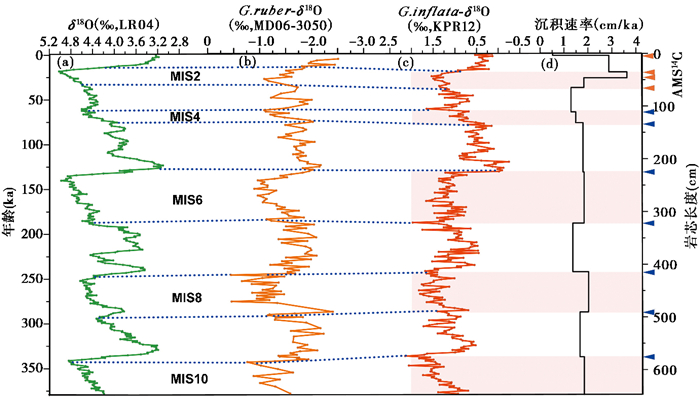
|
图 2 KPR12岩芯年代框架 (a)LR04-δ18O曲线[51];(b) MD06-3050岩芯G.ruber-δ18O曲线[29];(c)KPR12岩芯G.inflata-δ18O曲线;(d)沉积速率;橘色三角形: AMS 14C测年点;蓝色三角形: G.inflata-δ18O年龄控制点;粉色阴影为冰期 Fig. 2 Stratigraphic age model of core KPR12. (a)LR04 benthic-δ18O stack[51]; (b) G.ruber-δ18O of core MD06-3050[29]; (c)G.inflata-δ18O of core KPR12; (d)Linear sedimentary rate. Orange and blue triangles, AMS 14C dating and G.inflata-δ18O record of core KPR12 age control positions, respectively; pink shadow, glacial period |
KPR12岩芯沉积物中值粒径(Md)在4.49~213.16 μm范围内变化, 平均值为14.88 μm, 大致呈冰期细、间冰期粗的旋回特征。根据谢帕德沉积物命名法[37], 岩芯沉积物类型主要为粘土质粉砂和粉砂, 含砂质粉砂、粉砂质砂。粉砂组分含量较高, 约为28.90 % ~83.27 %, 平均68.86 %;砂和粘土组分含量变化范围分别为0~67.68 %和2.21 % ~38.77 %, 平均值为15.78 %和15.33 % (图 3)。砂含量变化较大, 高值主要出现在火山灰层, 含量达50 %以上。

|
图 3 KPR12岩芯沉积物粒度组成及其不同粒级端元的变化趋势 F1、F2、F3分别代表细粒、中粗粒、粗粒粒度端元;粉色阴影:冰期 Fig. 3 The grain size composition of core KPR12 sediments and the trends of different end members. F1, F2 and F3 represent fine grain, medium-coarse grain and coarse grain, respectively; pink shadow represents glacial period |
用Weibull分布函数定量分离沉积物不同粒级的端元[49], 可划分3个端元(图 4)。众数粒径为5.23 μm的细粒端元称为F1, 平均含量为41.02 %;F2为中粗粒端元, 其众数粒径为19.87 μm, 平均含量达到43.33 %;将众数粒径高达93.51 μm、平均含量为15.65 %的粗粒端元称为F3。同时, F1细粒沉积物粒径变化趋势和粘土含量的趋势较为一致, 大致呈冰期高、间冰期较低的变化趋势;F2与粉砂粒级变化趋势相近, 但冰期-间冰期旋回特征没有F1的明显;F3粗粒组分变化趋势与砂的含量变化趋势较吻合, 明显高值均出现在火山灰层(图 3)。
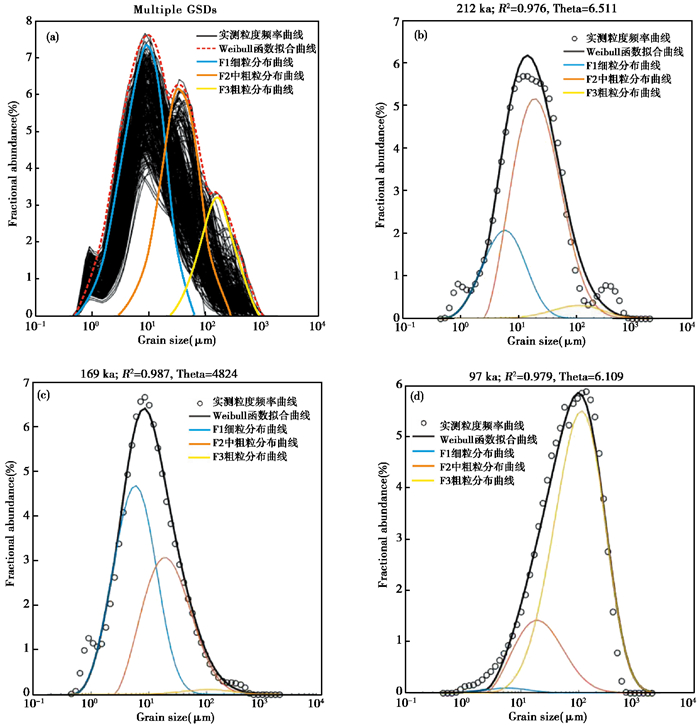
|
图 4 KPR12岩芯不同粒级端元频率分布 (a)KPR12岩芯284个样品粒度频率分布, 整体呈三峰态;(b)间冰期(212 ka)单个样品粒度分布;(c)冰期(169 ka)单个样品粒度分布;(d)火山灰层(97 ka)单个样品粒度分布 Fig. 4 Grain sizes frequency distribution of different end members in core KPR12. (a)Grain sizes frequency distribution of 284 samples in core KPR12, three peaks; (b)Grain size distribution of the individual sample in interglacial (212 ka); (c)Grain size distribution of the individual sample in glacial (169 ka); (d)Grain size distribution of the individual sample in ash layer (97 ka) |
图 5为KPR12岩芯有机碳氮含量、有机碳稳定同位素、生物硅含量变化趋势与海平面变化[52]对比。结果表明, KPR12岩芯的TOC含量变化范围在0.003 % ~0.443 %之间, 平均值为0.214 %, 其中几个最低值都位于火山灰层, 可能受火山喷发的影响(图 5c);与Md呈一定的负相关(图 6a, 相关系数R2=0.16)。与冲绳海槽中部的ECS12A岩芯(0.56 % ~1.68 %, 平均1.2 %)[30]和四国盆地的MD01-2422岩芯(0.24 % ~0.74 %, 平均0.47 %)[14]以及PC08岩芯(0.22 % ~0.96 %, 平均0.66 %)[14]相比, 本文TOC含量结果偏低, 推测这与该岩芯接受陆源河流输入少以及海区生产力较低有关。KPR12岩芯TOC含量具冰期-间冰期旋回特征, 冰期相对较高(OC冰期=0.25 %, OC间冰期=0.18 %), 尤其是MIS 2期(OCMIS2=0.33 %), 这与西北太平洋其他岩芯的TOC含量变化趋势一致[31]。此外, KPR12岩芯的TN含量介于0.006 % ~0.088 %, 平均值为0.043 %, 与TOC含量随年代变化趋势较相似(图 5c和5d), 呈高度正相关(图 6b, 相关系数R2=0.66), 说明沉积物中的碳、氮的来源及埋藏特征较为一致。
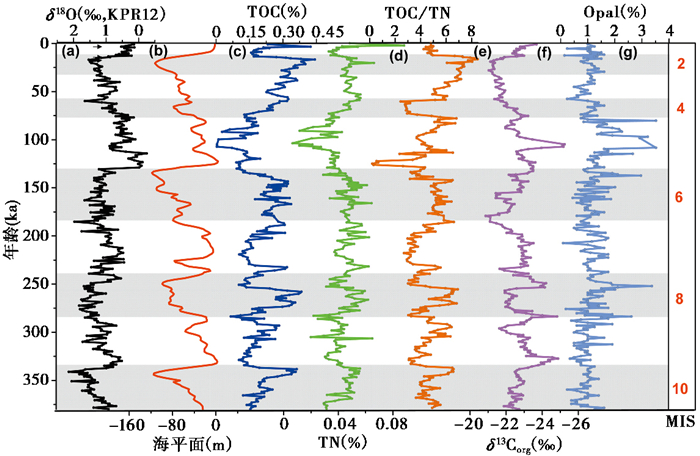
|
图 5 KPR12岩芯有机碳氮含量、有机碳稳定同位素、生物硅含量变化趋势与海平面变化[52]对比 灰色阴影为冰期 Fig. 5 The change of total organic carbon(TOC), nitrogen(TN)content, δ13CTOC and biological silicon(opal)content in core KPR12 and comparison with sea level change[52](gray shadow represents glacial period) |
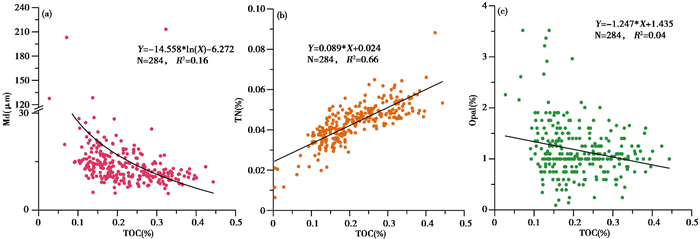
|
图 6 KPR12岩芯的TOC与Md、TN、Opal含量之间的相关性 Fig. 6 Relationship of the percentages of TOC and TN, Md, Opal in core KPR12 |
如图 5f所示, KPR12岩芯的δ13CTOC值在-25.24 ‰ ~-21.04 ‰范围内波动, 平均值为-22.59 ‰。在MIS 5中期、MIS 9早、晚期偏负。δ13CTOC在冰期-间冰期间的波动, 可能表明不同有机质的来源贡献也具有冰期-间冰期的旋回变化[14]。TOC/TN值在0.21~8.47之间变化, 平均值为4.79, 其峰值与TOC含量的峰值较一致(图 5c和5e)。该岩芯的δ13CTOC和TOC/TN值指示其有机质是以海源贡献为主。
KPR12岩芯的Opal含量较低, 在0.10 % ~3.52 %范围内波动, 平均只有1.27 % (图 5g)。Opal含量冰期-间冰期变化趋势不明显, 最高值仅出现在MIS 8晚期、MIS 6晚期、MIS 5c和5a。Opal与TOC的变化趋势不同步、相关性很低(图 6c, 相关系数R2=0.04), 说明KPR12岩芯的Opal与TOC含量变化关系不大。
3 讨论 3.1 KPR12岩芯沉积有机碳来源本文利用δ13CTOC二元混合模型定量估算了该岩芯中不同来源有机碳的含量, 结果显示海源有机碳(OCM)绝对含量约为0.15 %、陆源有机碳(OCT)的绝对含量约为0.08 % (图 7d和7f), 前者与TOC含量的变化趋势几乎一致(图 7), 大致呈冰期高、间冰期低的趋势;同时计算得到OCM约占TOC的62 %, OCT仅占约38 % (图 7g和7e), 表明岩芯的沉积有机碳以海源贡献为主, 且冰期时的OCM贡献(约占67 %)相对间冰期(约占60 %)更高。类似地, 四国盆地的MD01-2422岩芯和PC08岩芯的OCT/TOC比例分别为约18 %和23 %, 说明这两根岩芯的有机质也主要为海源贡献, 也指示了冰期时日本南部和亚洲大陆沉积物中陆源有机质贡献较低[14]。本文研究区附近的日本岛屿只发育了少量小河流, 它们输送的陆源有机质有限[53]。冲绳海槽北部的岩芯U1428、U1429可接受来自九州西南部以及东亚大陆的河流输送[17], 但与这两根岩芯相比, KPR12岩芯距离陆架更远, 水深更深, 来自九州岛屿的河流输入在复杂的海流作用与长距离的输送过程中, 对KPR12岩芯的影响可基本忽略。
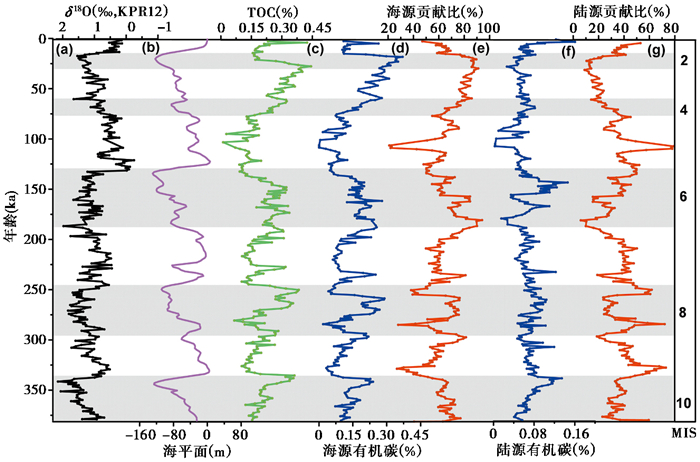
|
图 7 KPR12岩芯海源、陆源有机碳贡献变化与海平面变化[52]对比 Fig. 7 Contribution changes of organic carbon from marine and terrestrial source in core KPR12 and comparation with sea level change[52] |
黑潮被认为是低纬向中高纬地区输送热量、物质的重要枢纽[16], 在其传输过程中, 可将沿途大洋物质携带至研究区[54]。Kao等[25]的三维海洋模型表明, 随着海平面的下降, 黑潮的运输量减少, 流向也发生了改变。有研究采用粘土矿物比值指示黑潮强度变化[16~17], 认为黑潮主要受东亚夏季风和ENSO过程的调控, 表现为夏季风增强, 黑潮强度增强, 同时低海平面时期黑潮强度也显示减弱。总体来说, 黑潮在低海平面时期减弱、在海平面上升时增强, 这与KPR12岩芯陆源有机碳贡献的变化趋势大体一致(图 7b和7g)。台湾造山带和亚洲大陆都具有高沉积物输送量的特征[53], 陆源物质可能经河流搬运到西太平洋, 通过洋流输送到研究区[55]。冰期时海平面下降, 东海大陆架大面积暴露, 使得松散的陆架沉积物接受侵蚀和风化[56];间冰期时气候开始变暖、降水增加, 亚洲大陆河流(长江、黄河等)将向其边缘海(如东海)输入更多的亚洲大陆物质[30], 同时海平面上升促进风化产物再悬浮搬运沉积[57], 开始逐渐增强的黑潮[17]可能携带更多来自古长江和台湾等的陆源物质并影响本研究区[54]。
其次, 风尘输入也可能给KPR12岩芯带来部分陆源有机质。作为全球第二大粉尘源区, 亚洲内陆干旱区释放的粉尘是西北太平洋(尤其是开放大洋)沉积物中陆源组分的重要组成之一[20]。因此, 西风/东亚冬季风对本研究区物质输送有着重要影响[58], 除了输送营养物质外, 还可能带来亚洲大陆的陆源有机质。但值得注意的是, 在风尘输入的冰期-间冰期旋回中, 冰期时风尘源区发育有机质含量低的黄土为主, 间冰期主要发育有机质含量相对较高的古土壤[59~60], 这可能对KPR12冰期时陆源有机质贡献的低值有一定影响。
3.2 风尘输入与初级生产力研究表明, 东亚冬季风主要输送粗粒级沉积物(通常为>20 μm)[61], 细粒粉尘(< 20 μm, 通常只有几微米)主要由西风通过长距离的高空悬浮输送到太平洋[62]。本文对比了前人在西北太平洋的粒度端元研究, 在奄美三角盆地U1438A岩芯中3.5 μm细粒组分代表西风输运为主的物质输入[28], 西菲律宾海MD06-3050岩芯的14~22 μm组分可能主要代表东亚冬季风物质输入[21], 而该海域受周围火山事件频发的影响, 数十微米的粒级组分主要指示火山物质贡献[21, 23, 28]。因此, 本文KPR12岩芯沉积物粒度的不同端元F1 (5.23 μm)、F2 (19.87 μm)和F3 (93.51 μm)可能分别代表以西风、东亚冬季风以及火山物质组成为主的粒级端元。由图 8可以看出, 主要代表西风物质粒级的F1(图 8c)整体呈冰期较高、间冰期较低的趋势, 与V21-146风尘通量(图 8e)[32]、U1438A(图 8f)[63]岩芯风尘通量指标以及中国黄土(图 8g)[64]通量的冰期-间冰期旋回趋势较一致;而代表东亚冬季风物质粒级的F2(图 8d)的冰期-间冰期旋回特征没有F1的明显, 这可能指示西风的强度与搬运机制不同于东亚冬季风[21, 65], 同时粒度还可能受到水动力条件变化的影响。
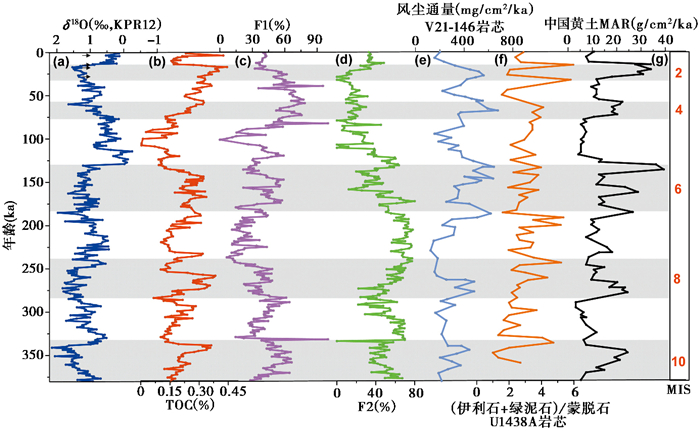
|
图 8 KPR12岩芯有机碳含量与粒度F1、F2含量以及中国黄土通量[64]、V21-146岩芯风尘通量[32]和U1438A岩芯[63]风尘通量指标对比 Fig. 8 Comparison of the organic carbon content in core KPR12 with grain size end members and the dust fluxes of Chinese loess[64], core V21-146[32] and core U1438A[63] |
以往的研究表明, 风尘被输送到海洋中可通过提供营养元素(如铁, 一种对光合作用至关重要的酶中必需的微量营养素)影响海洋初级生产力[66~67]。但这种“铁假说”具有明显的空间差异, 在硝酸盐等营养物质丰富而初级生产和固氮能力受铁缺乏限制的海区(如南大洋)[12], 通过风尘输入向海洋输送含铁物质可能促进增加海洋初级生产力, 可调节海洋生态系统对碳的吸收, 进而调节大气中CO2的浓度[68]。相反, 西北太平洋区域的海洋初级生产力可能并不是由风尘输入控制[13], 这还有待确认。
沉积物中TOC和Opal含量作为古海洋生产力指标的适用性主要取决于海洋有机质来源及其在沉积物中的保存条件[69]。结合图 5和图 6c可知, KPR12岩芯的TOC含量与Opal含量在冰期-间冰期旋回中的变化趋势不一致、相关性低, 这说明该区的海洋初级生产力可能并不是导致其TOC含量变化的关键因素, 可能与TOC向深海传输时的降解与保存过程有关。海洋的初级生产固碳含量在空间和时间上有所变化, 大部分有机质一般在几十米到几百米水深范围内被微生物降解回到水柱中[70], 极少部分(约为0.1 % ~10.0 %)继续向下沉降至深海埋藏[71]。
已有研究发现, 西北太平洋的沉积物TOC含量变化趋势与冰期风尘输入增强是一致的, 例如北太平洋S-2岩芯的TOC含量在冰期增加, 其中LGM值最高, 与LGM期高Opal通量以及风尘最大通量一致[31];西菲律宾海Ph05-5岩芯中的风尘通量与古生产力的耦合关系表明冰期时高生产力可能与高风尘通量有关[23]。参照北太平洋V21-146岩芯[32]和奄美盆地U1438A岩芯[63]的近40万年来风尘记录(图 8), 发现风尘输入的高值大致与KPR12岩芯的TOC高值是一致的, 但风尘输入与海洋初级生产力耦合关系的一个关键检验条件是表层营养盐的供应与消耗[12]。与南大洋的丰富营养盐赋存相比, 西北太平洋海域的营养盐浓度较低, 同时受亚北极太平洋区域永久温跃层[72]的影响, 导致营养物质上涌的减少, 因此冰期时营养盐供应不足可能是西北太平洋风尘输入与海洋初级生产力解耦的重要原因, 而水柱输运过程以及底层水体氧化还原条件可能对研究区沉积有机碳的后期埋藏保存有更重要的影响。
3.3 有机碳的埋藏与保存通常上层水体有机质在到达海底之前, 大部分通过微生物的呼吸作用分解而被消耗[73]。现代海洋沉积物中TOC的全球埋藏通量仅仅约占全球初级生产力的0.1 % [74]。因此, 除了海洋初级生产力可控制研究区TOC含量的变化外, 水体环境变化对有机质保存条件的影响也是TOC埋藏过程中的制约因素。
冰期较低的水温可能降低了微生物对有机质的降解程度, 从而使得有机质向深海转移和埋藏的效率有所提高[3]。如图 9c所示, 全球平均表层海温38万年以来的记录显示为冰期低、间冰期高的明显旋回特征[75]。同时Ikehara等[14]利用四国盆地MD01-2422岩芯的烯酮重建了表层水温, 认为日本南部四国盆地的海温降低与黑潮源区——西太平洋暖池和苏禄海的冰期降温有关, 这可能减少上层水柱中有机质的降解, 从而影响有机质向深海沉积和保存。结合北太平洋ODP1208站的深海水温冰期旋回记录[33], KPR12岩芯冰期更高的有机碳埋藏可能与较低的水温有关。
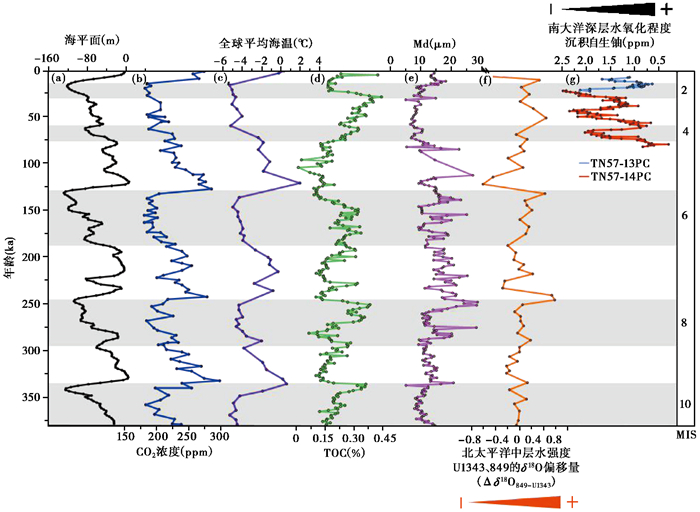
|
图 9 KPR12岩芯有机碳含量、中值粒径变化与海平面变化[52]、大气CO2浓度、全球平均表层海温、北太平洋中层水强度[75]和南大洋深层水氧化程度[79]的变化对比 U1343岩芯: 54°33′N, 176°49′E, 1950 m;849岩芯: 0°11′N, 110°31′E, 3851 m;TN57-13PC岩芯: 53°2′S, 5°1′E, 2848 m;TN57-14PC岩芯: 52°0′S, 4°5′E, 3648 m Fig. 9 Comparison of the changes in organic carbon content and median grain size of core KPR12 and sea level[52], atmospheric CO2 concentration, global average surface sea temperature, North Pacific Intermediate Water[75] and oxygenation in Deep Water of Southern Ocean[79]. U1343 Site:54°33′N, 176°49′E, 1950 m; 849 Site:0°11′N, 110°31′E, 3851 m; TN57-13PC Site:53°2′S, 5°1′E, 2848 m; TN57-14PC Site:52°0′S, 4°5′E, 3648 m |
研究已发现, 有机质的埋藏保存随着氧气浓度及其暴露时间的增加而减少[76]。在这方面, 由于现代北太平洋没有深水形成, 该区深水通风条件的变化主要由南大洋的水团运动决定[35, 77], 例如环南极深层水(CDW)和南极底层水(AABW)[78], 并通过改变底层的氧化还原条件, 进而可能影响该区沉积有机碳的埋藏保存。如图 9g所示, 南大洋的深层水氧化程度的旋回特征与本文TOC含量冰期高、间冰期低的变化相一致[79]。另一方面, 已研究表明黑潮强度对冲绳海槽中部有机碳埋藏效率的变化有直接影响[47];且冰期海平面下降可导致黑潮减弱[17], 因此黑潮在冰期-间冰期尺度上的强度变化可能与研究区上层水柱中有机质的降解也有关系。此外, 由于北太平洋中层水(NPIW)的影响范围可达热带太平洋[34], 冰期时NPIW的形成和加强(图 9f)也可能增加研究区上层水柱的溶解氧[75, 80], 影响上层水柱有机质的降解, 进而影响了沉积有机碳的埋藏保存, 这还有待进一步确认。
同时, 沉积物有机质-矿物颗粒的相互作用也是影响有机质保存的重要因素[81], 有机质与细颗粒物尤其粘土矿物的结合一直被认为在全球固碳中发挥重要作用[82~84]。由于矿物颗粒对有机质的吸附聚合作用, 可促进颗粒有机质向深海更快速的输运而更有利于有机质的埋藏保存[3, 49, 69]。由图 6a和图 9e可以看出, KPR12岩芯沉积物的粒径大部分小于20 μm, 且TOC含量随着粒径的减小而增加, 表明KPR12岩芯的有机碳可能受到细粒沉积物的吸附和保护作用。根据前人对奄美三角盆地U1438A岩芯的粘土矿物研究, 这些细粒组分可能主要为风尘输入的亚洲大陆粘土矿物(以伊利石、蒙脱石为主)[63]。冰期时海平面下降, 陆架大规模暴露及风尘作用可向外海输送更多的细粒物质, 并通过与水体有机质的结合加速其向底部输运转移[69], 这或对该区有机碳的埋藏保存有一定的促进作用。
4 结论本文初步揭示了西北太平洋KPR12岩芯近40万年的沉积记录具有较显著的冰期-间冰期旋回特征, 并初步阐述了该区有机碳埋藏与陆源输入、海洋初级生产力与海洋环境变化之间的响应关系。
(1) KPR12岩芯沉积物类型以粘土和粉砂为主, 平均中值粒径14.88 μm, 冰期沉积物颗粒更细;粒度端元可分离出F1 (5.23 μm)和F2 (19.87 μm)细粒组分作为西风和东亚冬季风风尘粒级的参考指标, 结果显示冰期风尘输入增加。
(2) 本文中TOC含量相比其他海区较低, 平均为0.214 %, 呈冰期相对更高的变化趋势。本文利用二元混合模型估算有机碳来源以海源有机碳为主(约62 %), 变化趋势与TOC一致。陆源输入的主控因素为风尘输入和黑潮的变化, 黑潮增强可能对陆源有机碳在间冰期的贡献升高产生影响。此外, TOC相关分析表明海洋初级生产力可能不是控制该岩芯有机碳含量变化的主要原因。
(3) 冰期-间冰期的海洋水体环境和物源输入的变化可能是制约本区TOC埋藏保存的重要因素。冰期低温、水体通风条件的变化以及更多的陆源细颗粒输入对本区有机质的沉积保存有更好的促进作用, 更有利于有机碳的埋藏。
致谢: 本文是中日韩西北太平洋调查合作研究的部分成果, 感谢KH16-6航次全体工作人员为取得高质量岩芯的辛勤付出;感谢同济大学海洋地质国家重点实验室的江小英博士, 为本文的浮游有孔虫氧碳同位素测定所做的工作;感谢中国科学院海洋研究所于兆杰博士提供的浮游有孔虫氧同位素数据。特别感谢审稿专家和编辑部杨美芳老师宝贵的修改意见, 在此一并感谢!
| [1] |
焦念志, 李超, 王晓雪. 海洋碳汇对气候变化的响应与反馈[J]. 地球科学进展, 2016, 31(7): 668-681. Jiao Nianzhi, Li Chao, Wang Xiaoxue. Response and feedback of marine carbon sink to climate change[J]. Advances in Earth Science, 2016, 31(7): 668-681. |
| [2] |
黄邦钦, 刘光兴, 史大林, 等. 海洋生态系统储碳过程的多尺度调控及其对全球变化的响应[J]. 中国基础科学.科技计划, 2017, 1(6): 27-29. Huang Bangqin, Liu Guangxing, Shi Dalin, et al. Marine carbon sequestration:Multiscale regulation and response to global changes[J]. China Basic Science, 2017, 1(6): 27-29. |
| [3] |
Cartapanis O, Bianchi D, Jaccard L S, et al. Global pulses of organic carbon burial in deep sea sediments during glacial maxima[J]. Nature Communications, 2016, 7: 1-7. DOI:10.1038/ncomms10796 |
| [4] |
Petit J R, Jouzel J, Raynaud D, et al. Climate and atmospheric history of the past 420, 000 years from the Vostok ice core, Antarctica[J]. Nature, 1999, 399: 429-436. DOI:10.1038/20859 |
| [5] |
Jouzel J, Masson-Delmotte V, Cattani O, et al. Orbital and millennial Antarctic climate variability over the past 800, 000 years[J]. Science, 2007, 317: 793-796. DOI:10.1126/science.1141038 |
| [6] |
Broecker W S. Glacial to interglacial changes in ocean chemistry[J]. Progress in Oceanography, 1982, 11(2): 151-197. |
| [7] |
Pedersen T F. Increased productivity in the eastern Equatorial Pacific during the Last Glacial Maximum (19, 000 to 14, 000 yr B. P)[J]. Geology, 1983, 11: 16-19. DOI:10.1130/0091-7613(1983)112.0.CO;2 |
| [8] |
Lyle M. Climatically forced organic carbon burial in equatorial Atlantic and Pacific Oceans[J]. Nature, 1988, 335: 529-532. DOI:10.1038/335529a0 |
| [9] |
Sarnthein M, Winn K, Duplessy J C, et al. Global variations of surface ocean productivity in low and mid latitudes:Influence on CO2 reservoirs of the deep ocean and atmosphere during the last 21, 000 years[J]. Paleoceanography, 1988, 3(3): 361-399. |
| [10] |
Bradtmiller L I, Anderson R F, Sachs J P, et al. A deeper respired carbon pool in the glacial Equatorial Pacific Ocean[J]. Earth and Planet Science Letters, 2010, 299: 417-425. DOI:10.1016/j.epsl.2010.09.022 |
| [11] |
Klaas C, Archer D E. Association of sinking organic matter with various types of mineral ballast in the deep sea:Implications for the rain ratio[J]. Global Biogeochemical Cycles, 2002, 16(4): 1116-1129. |
| [12] |
Martinez-Garcia A, Daniel M S, Ren H J, et al. Iron fertilization of the Subantarctic Ocean during the last ice age[J]. Science, 2014, 343: 1347-1350. DOI:10.1126/science.1246848 |
| [13] |
Li D W, Zheng L W, Jaccard L S, et al. Millennial-scale ocean dynamics controlled export productivity in the subtropical North Pacific[J]. Geology, 2017, 45: 651-654. DOI:10.1130/G38981.1 |
| [14] |
Ikehara M, Akita D, Matsuda A. Enhanced marine productivity in the Kuroshio region off Shikoku during the last glacial period inferred from the accumulation and carbon isotopes of sedimentary organic matter[J]. Journal of Quaternary Science, 2009, 24(8): 848-855. |
| [15] |
Hu D X, Wu L X, Cai W J, et al. Pacific western boundary current and their roles in climate[J]. Nature, 2015, 522: 299-308. DOI:10.1038/nature14504 |
| [16] |
Zheng X F, Li A C, Kao S J, et al. Synchronicity of Kuroshio Current and climate system variability since the Last Glacial Maximum[J]. Earth and Planetary Science Letters, 2016, 452: 247-257. DOI:10.1016/j.epsl.2016.07.028 |
| [17] |
赵德博. 40万年以来冲绳海槽北部沉积演化史及其环境响应[D].青岛: 中国科学院海洋研究所博士论文, 2017: 82-98. Zhao Debo. Sedimentary Evolution in Northern Okinawa Trough and Their Environmental Response since the Last 400 ka[D]. Qingdao: The Doctoral's Dissertation of Institute of Oceanology, Chinese Academy of Sciences, 2017: 82-98. |
| [18] |
Shao Y P, Wyrwoll K H, Chappell A, et al. Dust cycle:An emerging core theme in Earth system science[J]. Aeolian Research, 2011, 2(4): 181-204. |
| [19] |
Wan S M, Yu Z J, Clift P D, et al. History of Asian eolian input to the West Philippine Sea over the last one million years[J]. Palaeogeography, Palaeoclimatology, Palaeoecology, 2012, 326-328: 152-159. DOI:10.1016/j.palaeo.2012.02.015 |
| [20] |
张文防, 李高军, 陈骏. 北半球大冰期(2.73 Ma)前后北太平洋风尘沉积突变[J]. 第四纪研究, 2019, 39(3): 525-534. Zhang Wenfang, Li Gaojun, Chen Jun. The abrupt change of aeolian dust in North Pacific sediments during major Northern Hemisphere glacial at ca. 2.73 Ma[J]. Quaternary Sciences, 2019, 39(3): 525-534. |
| [21] |
于兆杰, 万世明, 孙晗杰, 等. 近百年来亚洲风尘在西菲律宾海的沉积物粒度记录[J]. 地球环境学报, 2012, 3(2): 792-800. Yu Zhaojie, Wan Shiming, Sun Hanjie, et al. Grain-size records of Asian eolian input to the West Philippine Sea over the last one million years[J]. Journal of Earth Environment, 2012, 3(2): 792-800. |
| [22] |
Seo I, Lee Y I, Chan M. Y, et al. Sr-Nd isotope composition and clay mineral assemblages in eolian dust from the central Philippine Sea over the last 600 kyr:Implications for the transport mechanism of Asian dust[J]. Journal of Geophysical Research:Atmospheres, 2014, 119: 11492-11504. DOI:10.1002/2014JD022025 |
| [23] |
Jiang F Q, Zhou Y, Nan Q Y, et al. Contribution of Asian dust and volcanic material to the western Philippine Sea over the last 220 kyr as inferred from grain size and Sr-Nd isotopes[J]. Journal of Geophysical Research:Oceans, 2016, 121: 6911-6928. DOI:10.1002/2016JC012000 |
| [24] |
Xu Z K, Li T G, Clift P D, et al. Quantitative estimates of Asian dust input to the western Philippine Sea in the mid-late Quaternary and its potential significance for paleoenvironment[J]. Geochemistry, Geophysics, Geosystems, 2015, 16: 3182-3196. DOI:10.1002/-2015GC005929 |
| [25] |
Kao S J, Wu C R, Hsin Y C, et al. Effects of sea level change on the upstream Kuroshio Current through the Okinawa Trough[J]. Geophysical Research Letters, 2006, 33: 627-642. DOI:10.1029/2006GL026822 |
| [26] |
Gallagher S J, Kitamura A, Iryu Y, et al. The Pliocene to recent history of the Kuroshio and Tsushima Currents:A multi-proxy approach[J]. Progress in Earth and Planetary Science, 2015, 2: 17. DOI:10.1186/s40645-015-0045-6 |
| [27] |
王越奇, 宋金明, 袁华茂, 等. 西北太平洋黑潮源区沉积特征及黑潮输入对东海沉积物的影响[J]. 海洋科学, 2018, 42(9): 112-126. Wang Yueqi, Song Jinming, Yuan Huamao, et al. Sedimentary characteristics of the Kuroshio origination area and the influence of the Kuroshio intrusion on sediments of the East China Sea[J]. Marine Sciences, 2018, 42(9): 112-126. |
| [28] |
周烨, 蒋富清, 南青云, 等. 奄美三角盆地晚更新世以来碎屑沉积物粒度特征及其物源和古气候意义[J]. 地球科学进展, 2016, 31(3): 298-309. Zhou Ye, Jiang Fuqing, Nan Qingyun, et al. Grain-size distribution of detrital sediment in the Amami Sankaku Basin since Late Pleistocene and its provenance and palaeoclimate implications[J]. Advances in Earth Science, 2016, 31(3): 298-309. |
| [29] |
Sun H J, Li T G, Sun R T, et al. Calcareous nannofossil bioevents and microtektite stratigraphy in the Western Philippine Sea during the Quaternary[J]. Chinese Science Bulletin, 2011, 56(25): 2732-2738. |
| [30] |
Shao H, Yang S, Cai F, et al. Sources and burial of organic carbon in the middle Okinawa Trough during Late Quaternary paleoenvironmental change[J]. Deep-Sea Research Ⅰ, 2016, 118: 46-56. DOI:10.1016/j.dsr.2016.10.005 |
| [31] |
Amo M, Minagawa M. Sedimentary record of marine and terrigenous organic matter delivery to the Shatsky Rise, western North Pacific, over the last 130 kyr[J]. Organic Geochemistry, 2003, 34: 1299-1312. DOI:10.1016/S0146-6380(03)00113-X |
| [32] |
Hovan S A, Rea D K, Pisias N G, et al. A direct link between the China loess and marine δ18O records:Aeolian flux to the North Pacific[J]. Nature, 1989, 340(6231): 296-298. |
| [33] |
Ford H L, Raymo M E. Regional and global signals in seawater δ18O records across the mid-Pleistocene transition[J]. Geology, 2020, 48(2): 113-117. |
| [34] |
Max L, Rippert N, Lembke-Jene L, et al. Evidence for enhanced convection of North Pacific Intermediate Water to the low-latitude Pacific under glacial conditions[J]. Paleoceanography, 2017, 32(1): 41-55. |
| [35] |
Hu R, Piotrowski A M, Bostock H C, et al. Variability of neodymium isotopes associated with planktonic foraminifera in the Pacific Ocean during the Holocene and Last Glacial Maximum[J]. Earth and Planetary Science Letters, 2016, 447: 130-138. DOI:10.1016/j.epsl.2016.05.011 |
| [36] |
田军, 汪品先, 成鑫荣. 南海ODP1143站底栖有孔虫Cibicidoides与Uvigerina稳定氧碳同位素的均衡实验[J]. 地球科学——中国地质大学学报, 2004, 29(1): 1-6. Tian Jun, Wang Pinxian, Cheng Xinrong. Stable Isotope equilibrium teat between benthic foraminifer Cibicidoides and Uvigerina at ODP Site 1143, Southern South China Sea[J]. Earth Science-Journal of China University of Geosciences, 2004, 29(1): 1-6. |
| [37] |
国家海洋局908专项办公室. 海洋地质调查技术规程[M]. 北京: 海洋出版社, 2006: 4-7. The 908 Program Office of State Oceanic Administration. Technical Regulations for Marine Geological Survey[M]. Beijing: China Ocean Press, 2006: 4-7. |
| [38] |
De-Master D J. The supply and accumulation of silica in the marine environment[J]. Geochimica et Cosmochimica Acta, 1981, 45(10): 1715-1732. |
| [39] |
吴丹丹, 葛晨东, 高抒, 等. 长江口沉积物碳氮元素地球化学特征及有机质来源分析[J]. 地球化学, 2012, 41(3): 207-215. Wu Dandan, Ge Chendong, Gao Shu, et al. Carbon, nitrogen geochemical character and source analyses in Changjiang estuarine sediments[J]. Geochimica, 2012, 41(3): 207-215. |
| [40] |
程珂, 谢宇, 刘粤峰, 等. 东亚季风区石笋δ13C是否记录植被变化:从川东北石笋记录的Heinrich事件说起[J]. 第四纪研究, 2019, 39(4): 837-844. Cheng Ke, Xie Yu, Liu Yuefeng, et al. Can speleothem δ13C record vegetation changes in the East Asia summer monsoon regime? A story starting from Heinrich events recorded by speleothems from northeast Sichuan in Central China[J]. Quaternary Sciences, 2019, 39(4): 837-844. |
| [41] |
马雪云, 魏志福, 王永莉, 等. 末次冰盛期以来东北地区霍拉盆地湖泊沉积物记录的C3/C4植被演化[J]. 第四纪研究, 2018, 38(5): 1193-1202. Ma Xueyun, Wei Zhifu, Wang Yongli, et al. C3/C4 vegetation evolution recorded by lake sediments in the Huola basin, Northeast China since the Last Glacial Maximun[J]. Quaternary Sciences, 2018, 38(5): 1193-1202. |
| [42] |
王海粟, 党皓文, 翦知湣. 中更新世转型时期南海北部上层水体结构演化特征——ODP1146站浮游有孔虫稳定同位素记录[J]. 第四纪研究, 2019, 39(2): 316-327. Wang Haisu, Dang Haowen, Jian Zhimin. Variations in the upper water structure of northern South China Sea during the midPleistocene Climate Transition Period:Planktonic foraminifera oxygen isotope records of ODP site 1146[J]. Quaternary Sciences, 2019, 39(2): 316-327. |
| [43] |
王玥铭, 窦衍光, 徐景平, 等. 16 ka以来冲绳海槽中南部有机质来源及其对上升流演变的指示[J]. 第四纪研究, 2018, 38(3): 769-781. Wang Yueming, Dou Yanguang, Xu Jingping, et al. Organic matter source in the middle southern Okinawa Trough and its response to paleoenvironmental evolution since 16 ka[J]. Quaternary Sciences, 2018, 38(3): 769-781. |
| [44] |
Tyson R V. Sedimentary Organic Matter:Organic Facies and Palynofacies[M]. London: Chapman and Hall, 1995: 395-417.
|
| [45] |
Gao J, Wang Y, Pan S, et al. Spatial distributions of organic carbon and nitrogen and their isotopic compositions in sediments of the Changjiang Estuary and its adjacent sea area[J]. Journal of Geographical Sciences, 2008, 18(1): 46-58. |
| [46] |
Wada E, Kabaya Y, Tsuru K, et al. 13C and 15N abundance of sedimentary organic matter in estuarine areas of Tokyo Bay, Japan[J]. Mass Spectroscopy, 1990, 38(6): 307-318. |
| [47] |
Li D W, Chang Y P, Li Q, et al. Effect of sea-level on organic carbon preservation in the Okinawa Trough over the last 91 kyr[J]. Marine Geology, 2018, 399: 148-157. DOI:10.1016/j.margeo.2018.02.013 |
| [48] |
Sun D, Bloemendal J, Rea D K, et al. Grain-size distribution function of polymodal sediments in hydraulic and aeolian environments and numerical partitioning of the sedimentary components[J]. Sedimentary Geology, 2002, 152(3): 263-277. |
| [49] |
Sun D, Chen F, Bloemendal J, et al. Seasonal variability of modern dust over the Loess Plateau of China[J]. Journal of Geophysical Research, 2003, 108(21): 4665-4674. |
| [50] |
周宇, 蒋富清, 徐兆凯, 等. 近2 Ma帕里西-维拉海盆沉积物中碎屑组分粒度特征及其物源和古气候意义[J]. 海洋科学, 2015, 39(9): 86-93. Zhou Yu, Jiang Fuqing, Xu Zhaokai, et al. Grain-size distribution of detrital sediment in the Parece Vela Basin and its implication of provenance and palaeoclimate over the last 2 Ma[J]. Marine Sciences, 2015, 39(9): 86-93. |
| [51] |
Lisiecki L E, Raymo M E. A Pliocene-Pleistocene stack of 57 globally distributed benthic δ18O records[J]. Paleoceanography, 2005, 20: PA1003. DOI:10.1029/2004PA001071 |
| [52] |
Waelbroeck C, Labeyrie L, Michel E, et al. Sea-level and deep water temperature changes derived from benthic foraminifera isotopic records[J]. Quaternary Science Reviews, 2002, 21(1-3): 295-305. |
| [53] |
Milliman J D, Farnsworth K L. River Discharge to the Coastal Ocean:A Global Synthesis[M]. Cambridge: Cambridge University Press, 2011: 13-69.
|
| [54] |
Dou Y G, Yang S Y, Shi X F, et al. Provenance weathering and erosion records in southern Okinawa Trough sediments since 28 ka:Geochemical and Sr-Nd-Pb isotopic evidences[J]. Chemical Geology, 2016, 425: 93-109. DOI:10.1016/j.chemgeo.2016.01.029 |
| [55] |
Xu Z K, Li T G, Clift P D, et al. Bathyal records of enhanced silicate erosion and weathering on the exposed Luzon shelf during glacial lowstands and their significance for atmospheric CO2 sink[J]. Chemical Geology, 2018, 476: 302-315. DOI:10.1016/j.chemgeo.2017.11.027 |
| [56] |
Wan S M, Clift P D, Zhao D B, et al. Enhanced silicate weathering of tropical shelf sediments exposed during glacial lowstands:A sink for atmospheric CO2[J]. Geochimica et Cosmochimika Acta, 2017, 200: 123-144. DOI:10.1016/j.gca.2016.12.010 |
| [57] |
Hu D K, Boning P, Kohler C M, et al. Deep sea records of the continental weathering and erosion response to East Asian monsoon intensification since 14 ka in the South China Sea[J]. Chemical Geology, 2012, 326-327: 1-18. DOI:10.1016/j.chemgeo.2012.07.024 |
| [58] |
万世明, 徐兆凯. 西太平洋风尘沉积记录研究进展[J]. 海洋与湖沼, 2017, 48(6): 1208-1219. Wan Shiming, Xu Zhaokai. Research progress on eolian dust records in the west Pacific[J]. Oceanologia et Limnologia Sinica, 2017, 48(6): 1208-1219. |
| [59] |
楚纯洁, 赵景波, 周金风. 毛乌素沙地中部黄土-古土壤剖面沉积特征与地层划分[J]. 第四纪研究, 2018, 38(3): 623-635. Chu Chunjie, Zhao Jingbo, Zhou Jinfeng. Sedimentary characteristics and stratigraphic division of the loess-paleosol section in Wushen County, the central Mu Us dune field in North China[J]. Quaternary Sciences, 2018, 38(3): 623-635. |
| [60] |
陈洪云, 孙有斌. 黄土高原风尘沉积的物质来源研究:回顾与展望[J]. 第四纪研究, 2008, 28(5): 892-900. Chen Hongyun, Sun Youbin. Study on provenance of eolian dust deposits on the Chinese Loess Plateau:Retrospects and prospects[J]. Quaternary Sciences, 2008, 28(5): 892-900. |
| [61] |
Sun D. Monsoon and westerly circulation changes recorded in the Late Cenozoic aeolian sequences of Northern China[J]. Global Planet Change, 2004, 41(1): 63-80. |
| [62] |
Merrill J T, Uematsu M, Bleck R. Meteorological analysis of long-range transport of mineral aerosol over the North Pacific[J]. Journal of Geophysical Research, 1989, 94: 8584-8598. DOI:10.1029/jd094id06p08584 |
| [63] |
刘华华, 蒋富清, 周烨, 等. 晚更新世以来奄美三角盆地粘土矿物的来源及其对古气候的指示[J]. 地球科学进展, 2016, 31(3): 286-297. Liu Huahua, Jiang Fuqing, Zhou Ye, et al. Provenance of clay minerals in the Amami Sankaku Basin and their paleoclimate implications since Late Pleistocene[J]. Advances in Earth Science, 2016, 31(3): 286-297. |
| [64] |
Sun Y, An Z. Late Pliocene-Pleistocene changes in mass accumulation rates of eolian deposits on the central Chinese Loess Plateau[J]. Journal of Geophysical Research:Atmospheres (1984-2012), 2005, 110: 1-8. DOI:10.1029/2005JD006064 |
| [65] |
Ding Z L, Derbyshire E, Yang S L, et al. Stacked 2.6-Ma grain size record from the Chinese loess based on five sections and correlation with the deep sea δ18O record[J]. Paleoceanography, 2002, 17(13): 511-521. |
| [66] |
Tegen I, Lacis A A, Fung I. The influence on climate forcing of mineral aerosols from disturbed soils[J]. Nature, 1996, 380: 419-422. DOI:10.1038/380419a0 |
| [67] |
Jickells T D, An Z S, Andersen K K, et al. Global iron connections between desert dust, ocean biogeochemistry, and climate[J]. Science, 2005, 308: 67-71. DOI:10.1126/science.1105959 |
| [68] |
Maher B A, Prospero J M, Mackie D, et al. Global connections between aeolian dust, climate and ocean biogeochemistry at the present day and at the Last Glacial Maximum[J]. Earth Science Reviews, 2010, 99: 61-97. DOI:10.1016/j.earscirev.2009.12.001 |
| [69] |
Schoepfer S D, Shen J, Wei H Y, et al. Total organic carbon, organic phosphorus, and biogenic barium fluxes as proxies for paleomarine productivity[J]. Earth-Science Reviews, 2015, 149: 23-52. DOI:10.1016/j.earscirev.2014.08.017 |
| [70] |
王汝建, 肖文申, 向霏, 等. 北冰洋西部表层沉积物中生源组分及其古海洋学意义[J]. 海洋地质与第四纪地质, 2007, 27(6): 61-69. Wang Rujian, Xiao Wenshen, Xiang Fei, et al. Distribution pattern of biogenic components in surface sediments of the Western Arctic Ocean and their paleoceanographic implications[J]. Marine Geology & Quaternary Geology, 2007, 27(6): 61-69. |
| [71] |
Hedges J I, Keil R G. Sedimentary organic matter preservation:An assessment and speculative synthesis[J]. Marine Chemical, 1995, 49: 137-139. DOI:10.1016/0304-4203(95)00008-F |
| [72] |
Haug G H, Sigman D N, Tiedemann R, et al. Onset of permanent stratification in the subarctic Pacific Ocean[J]. Nature, 1999, 401(6755): 779-782. |
| [73] |
Opsahl S, Benner R. Distribution and cycling of terrigenous dissolved organic matter in the ocean[J]. Nature, 1997, 386: 480-482. DOI:10.1038/386480a0 |
| [74] |
Hedges J I, Keil R G, Benner R. What happens to terrestrial organic matter in the ocean?[J]. Elsevier Science, 1997, 27(5/6): 195-212. |
| [75] |
Worne S, Kender S, George E A, et al. Coupled climate and subarctic Pacific nutrient upwelling over the last 850, 000 years[J]. Earth and Planetary Science Letters, 2019, 522: 87-97. DOI:10.1016/j.epsl.2019.06.028 |
| [76] |
Hartnett H E, Keil R G, Hedges J I, et al. Influence of oxygen exposure time on organic carbon preservation in continental margin sediments[J]. Nature, 1998, 391(6667): 572-574. |
| [77] |
Okazaki Y, Timmermann A, Menviel L, et al. Deepwater formation in the North Pacific during the Last Glacial Termination[J]. Science, 2010, 329: 200-204. DOI:10.1126/science.1190612 |
| [78] |
Rippeert N, Max L, Mackensen A, et al. Alternating influence of northern versus southern-sourced water masses on the Equatorial Pacific subthermocline during the past 240 ka[J]. Paleoceanography, 2017, 32: 1256-1274. DOI:10.1002/2017PA003133 |
| [79] |
Jaccard S L, Galbraith E D, Martinez-Garcia A, et al. Covariation of deep Southern Ocean oxygenation and atmospheric CO2 through the last ice age[J]. Nature, 2016, 530: 207-210. DOI:10.1038/-nature16514 |
| [80] |
Horikawa K, Asahara Y, Yamamoto K, et al. Intermediate water formation in the Bering Sea during glacial periods:Evidence from neodymium isotope ratios[J]. Geology, 2010, 38: 435-438. DOI:10.1130/g30225.1 |
| [81] |
石学法, 胡利民, 乔淑卿, 等. 中国东部陆架海沉积有机碳研究进展:来源、输运与埋藏[J]. 海洋科学进展, 2016, 34(3): 313-327. Shi Xuefa, Hu Limin, Qiao Shuqing, et al. Progress in research of sedimentary organic carbon in the East China Sea:Source, dispersal and sequestration[J]. Advance in Marine Science, 2016, 34(3): 313-327. |
| [82] |
Berber R A. Sedimentary pyrite formation[J]. American Journal of Science, 1970, 268(1): 1-23. |
| [83] |
Keil R G, Tsamakis E, Fuh C B, et al. Mineralogical and textural controls on the organic composition of coastal marine sediments:Hydrodynamic separation using SPLITT-fractionation[J]. Geochimica et Cosmochimica Acta, 1994, 58(2): 879-893. |
| [84] |
Kaiser K, Guggenberger G. Mineral surfaces and soil organic matter[J]. European Journal of Soil Science, 2010, 54(2): 219-236. |
2 Laboratory for Marine Geology, Pilot National Laboratory for Marine Science and Technology(Qingdao), Qingdao 266237, Shandong;
3 Collaborative Innovation Center of South China Sea Studies, Nanjing University, Nanjing 210093, Jiangsu;
4 Kochi University, Center for Advanced Marine Core Research, Kochi, Japan 783-8502;
5 Center for Isotope Geochemistry and Geochronology, Pilot National Laboratory for Marine Science and Technology(Qingdao), Qingdao 266237, Shandong)
Abstract
In the global carbon cycle, the burial of organic carbon(OC)in marine sediments in geological periods is closely related to terrestrial input, marine primary productivity and marine environment. There is a lack of long-term OC record in the Northwest Pacific(NWP)Ocean, where is an ideal target region for studying the source, burial and preservation of OC with its environmental implication in the glacial-interglacial cycles. In this study, based on the glacial-interglacial timescale, we present a record of sedimentary OC burial from northern Kyushu-Palau Ridge since Late Quaternary and preliminarily explain their controlling factors and the potential environmental implication.The gravity core KPR12 (647 cm length)was collected from the northern Kyushu-Palau Ridge in the NWP(29°28'N, 133°37'E; 2590 m in depth)in 2016, where is affected by the Kuroshio Current, the dust input from Asian Continent and the volcanic eruption of Kyushu Island in Japan. We used AMS 14C dating, planktonic foraminiferal oxygen isotope records to establish the age model. We also analyzed the sediment grain size, opal, total organic carbon(TOC), total nitrogen(TN), stable carbon isotope of TOC(δ13CTOC), and finally established the sediment record of OC burial in this area through the last 400 ka.The results showed that the mean TOC content is 0.214%, which is characterized by higher values during glacial periods compared to that in the interglacial time(OCGlacial=0.25%, OCInterglacial=0.18%). The mean δ13CTOC value in this core is -22.59‰, indicating a mixed OM sources with the dominant contribution from marine origin(ca. 62%). There existed a good correlation trend between TOC and marine-derived OC, suggesting that the variation of TOC record may co-varied with the changes of marine-derived OC; while the terrestrial OC is probably correlated to the Kuroshio Current and dust input. The variations of the end members of grain size can reflect the influence of Westerlies(F1:5.23 μm, fine grain), East Asian Winter Wind(F2:19.87 μm, medium-coarse grain)and volcanic material(F3:93.51 μm, coarse grain)input, with a higher dust input during the glacial periods, which is consistent with the patterns of TOC records.According to the decoupled variation trends and few correlations between TOC and Opal(R2=0.04)in core KPR12, it means that marine primary productivity may not be the main factor to control the OC burial. Furthermore, the Kuroshio Current, North Pacific Intermediate Water(NPIW), Antarctic Bottom Water(AABW)and Circumpolor Deep Water(CDW)may together influence the change of dissolved oxygen in the bottom water column of NWP and promote the burial and preservation of the sedimentary OC in the study area. On the other hand, the increased input of fine particles from terrestrial sources during the glacial periods could also enhance the burial and preservation of OC through a quick transfer and deposition of particulate OM in the water column. In summary, the ventilation variation during the glacial-interglacial cycles, Kuroshio condition and development of the NPIW as well as the terrigenous fine-grained sediment input could work together to regulate the degradation and burial of sediment OC in this area. 2020, Vol.40
2020, Vol.40

